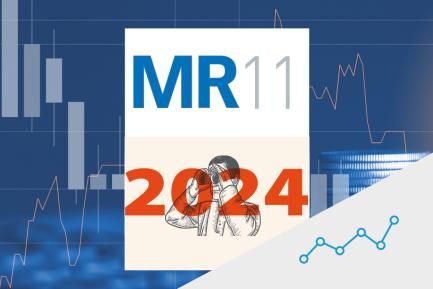
Period of turbulence in the financial markets

The return after summer was marked by a sharp rebound in volatility in the financial markets, in a context of high uncertainty and reduced risk appetite. In addition to the escalation of the conflict with Russia and the rapid deterioration of macroeconomic indicators around the world, the announcement of a fiscal stimulus plan in the United Kingdom set off alarm bells among investors over the coordination of economic policy and the sustainability of sovereign debt. It is feared that a shift in bias towards an expansionary fiscal policy may need to be offset with further monetary policy tightening. In this regard, the central banks continued to focus on the inflationary risk, introducing substantial rate hikes and giving indications of further hikes to come in the coming months. Thus, implicit interest rates in the money markets reflected a rise in official rate expectations in September, triggering a widespread tightening of financial conditions, which was most notable in the sharp rally in sovereign debt yields and the strengthening of the dollar. The turbulence and disruption in some markets led to unexpected interventions by some monetary authorities.

Following the continued inflationary pressures during the summer, investors’ attention was even more focused than before on the ECB and Fed’s September meetings. On the one hand, the European institution decided to raise official interest rates by 75 bps, a move unprecedented in its history. It justified the rise with the euro area’s high inflation and the expectation that it will remain above 2% for a long time, which was also the reason why Christine Lagarde anticipated «more than two but less than five» additional rate hikes in the coming months. The tightening of financial conditions was accompanied by a significant downward revision of the euro area’s economic forecasts for the second half of 2022 and Q1 2023. The Fed, meanwhile, also unanimously decided to raise interest rates by 75 bps (up to the 3.00%-3.25% range), moving into restrictive territory (above 2.5%, the level which the central bank considers neutral). It expects inflationary pressures to remain very high over the coming months, and under the commitment to restore price stability Jerome Powell reiterated the Fed members’ resolute determination to continue tightening monetary policy until there is a clear downward trend in prices, even if it could stunt economic growth. According to the average FOMC voter, rate hikes of 1.25 pps this year and of 0.25 pps in 2023 would be needed to reach the desired level of monetary tightening. In other advanced economies, the central banks of England, Switzerland, Canada and Sweden also opted to raise their interest rates (by 50, 75 and 100 bps, respectively), in an attempt to curb the rally in consumer prices and avoid further depreciation of their currencies against the dollar.

The confirmation of the more aggressive monetary plans in the US and the euro area shook the bond markets. In both cases, the sovereign yield curves rose significantly in September, particularly in the shorter terms (+79 bps to 4.28% in the case of 2-year treasuries and +56 bps to 1.76% for the 2-year German Schatz, in September), driven by investors’ expectations regarding the scale and speed of the central banks’ rate hikes. In the euro area, the risk premia remained relatively stable, despite a widening of the Italian spread in the sessions following the presidential elections. In Europe, much of the attention was still focused on the sharp decline in British bond prices following the government’s announcement of a historic tax cut over the next five years (amounting to 160 billion pounds). In the face of the growing perception of economic and financial instability generated by the announcement, the Bank of England intervened in the bond market by committing to buy long-term sovereign bonds (gilts) to the tune of 65 billion pounds. In the first sessions of October, this action and the worsening of some economic activity data in the US helped to alleviate the upward pressure on global sovereign yield curves.

The rise in the fed funds rate, the deterioration of the global growth outlook due to the war in Ukraine, as well as the energy crisis, continued to fuel the strength of the dollar, which has been trading at its highest levels for nearly two decades. This led several central banks to intervene in order to curb the depreciation of their currencies, including the Bank of Japan (for the first time since 1998) and the Bank of England, which managed to provide some support for the pound through bond purchases. Emerging-country central banks have also become increasingly vigilant in the face of the depreciation of their currencies, and the People’s Bank of China has even warned of possible intervention to defend the stability of the yuan.

In this context, risk aversion dominated the markets and the major stock market indices ended September with further declines for the month as a whole (S&P 500 –24.8% and EuroStoxx 50 –22.8%, in the year), as a result of the impact which the tighter financial and economic conditions will have on corporate margins. In the commodity markets, doubts surrounding global economic growth and the resilience of the dollar also led to declines in the Brent barrel price, bringing it to pre-war levels. Similarly, the increase in natural gas reserves in the EU ahead of winter allowed natural gas prices (Dutch TTF) to moderate, despite supplies through Nord Stream 1 being cut off. However, in early October, the first signs of a slowdown in the US economy nudged investor sentiment towards risky assets, given the possibility that the Fed may have to contain the pace of its interest rate hikes.




